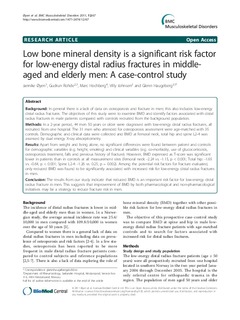| dc.contributor.author | Øyen, Jannike | |
| dc.contributor.author | Rohde, Gudrun | |
| dc.contributor.author | Hochberg, Marc | |
| dc.contributor.author | Johnsen, Villy | |
| dc.contributor.author | Haugeberg, Glenn | |
| dc.date.accessioned | 2011-05-12T12:06:41Z | |
| dc.date.available | 2011-05-12T12:06:41Z | |
| dc.date.issued | 2011 | |
| dc.identifier.citation | Oyen, J., Rohde, G., Hochberg, M., Johnsen, V., & Haugeberg, G. (2011). Low bone mineral density is a significant risk factor for low-energy distal radius fractures in middle-aged and elderly men: A case-control study. Bmc Musculoskeletal Disorders, 12. doi: 10.1186/1471-2474-12-67 | |
| dc.identifier.issn | 1471-2474 | |
| dc.identifier.uri | http://hdl.handle.net/11250/138665 | |
| dc.description | Published version of an article from: Bmc Neurology. Also available from the publisher: http://dx.doi.org/10.1186/1471-2474-12-67. Open Access | en_US |
| dc.description.abstract | Background: In general there is a lack of data on osteoporosis and fracture in men; this also includes low-energy distal radius fractures. The objectives of this study were to examine BMD and identify factors associated with distal radius fractures in male patients compared with controls recruited from the background population. Methods: In a 2-year period, 44 men 50 years or older were diagnosed with low-energy distal radius fractures, all recruited from one hospital. The 31 men who attended for osteoporosis assessment were age-matched with 35 controls. Demographic and clinical data were collected and BMD at femoral neck, total hip and spine L2-4 was assessed by dual energy X-ray absorptiometry. Results: Apart from weight and living alone, no significant differences were found between patient and controls for demographic variables (e.g. height, smoking) and clinical variables (e.g. co-morbidity, use of glucocorticoids, osteoporosis treatment, falls and previous history of fracture). However, BMD expressed as T-score was significant lower in patients than in controls at all measurement sites (femoral neck: -2.24 vs. -1.15, p < 0.001; Total hip: -1.65 vs. -0.64, p < 0.001; Spine L2-4: -1.26 vs. 0.25, p = 0.002). Among the potential risk factors for fracture evaluated, only reduced BMD was found to be significantly associated with increased risk for low-energy distal radius fractures in men. Conclusion: The results from our study indicate that reduced BMD is an important risk factor for low-energy distal radius fracture in men. This suggests that improvement of BMD by both pharmacological and non-pharmacological initiatives may be a strategy to reduce fracture risk in men. | en_US |
| dc.language.iso | eng | en_US |
| dc.publisher | Biomedcentral | en_US |
| dc.title | Low bone mineral density is a significant risk factor for low-energy distal radius fractures in middle-aged and elderly men: A case-control study | en_US |
| dc.type | Journal article | en_US |
| dc.type | Peer reviewed | en_US |
| dc.subject.nsi | VDP::Medical disciplines: 700::Health sciences: 800::Preventive medicine: 804 | en_US |
| dc.source.pagenumber | 1-6 | en_US |
